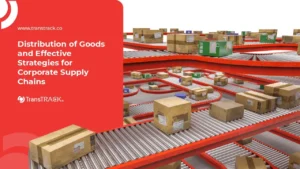Here are 6 Processes in the Warehouse Management System (WMS)!
Posted on March 19, 2024 by Nur Wachda Mihmidati

The Warehouse Management System process is very important in terms of logistics. In the era of globalization and increasingly fierce business competition, operational efficiency is the main key in maintaining company sustainability and growth. One area that plays a crucial role in the supply chain is the warehouse or distribution center. How a company manages its warehouse affects not only product availability but also the overall efficiency from production to delivery.
This is where a Warehouse Management System process plays an important role. WMS is not just a software or computer system, but rather a strong operational foundation for companies to manage inventory, fulfill orders, and ensure timely delivery to customers.
In this TransTRACK article, we will dive deeper into the standard processes that a WMS involves, from receiving goods to shipping, and why such a system is crucial to the success of modern businesses. Let’s explore how a WMS helps companies optimize every step in their warehouse operations, improving efficiency, accuracy, and overall customer satisfaction.
What is a warehouse management system (WMS)
A Warehouse Management System (WMS) is a software or computer system designed to manage and optimize operational processes within a warehouse or distribution center. The main objective of a WMS is to ensure efficiency, accuracy, and transparency in inventory management and overall warehouse operations.
Key features of a warehouse management system may include:
Inventory Management
Track the entry and exit of goods, monitor inventory quantities, and optimize the placement of goods within the warehouse to minimize the time and effort required to access them.
Location Management
Determining the optimal storage location for items in the warehouse, including the management of shelves, zones, and storage plots.
Order Management
Process customer orders, from processing to delivery, ensuring proper picking and efficient packaging.
Goods Tracking
Track the movement of goods within the warehouse, both incoming and outgoing, using technologies such as barcodes or RFID (Radio-Frequency Identification).
Operational Optimization
Optimize warehouse operational processes, such as arranging picking routes, allocating resources, and scheduling employee tasks.
Reporting and Analysis
Provide reports and analysis on warehouse performance, including inventory levels, order processing time, and overall operational efficiency.
With an effective warehouse management system in place, companies can increase productivity, reduce operational costs, and improve customer satisfaction through more efficient management of inventory and distribution processes.
Standard warehouse management system process
Standard processes in a Warehouse Management System (WMS) usually include the following steps:
Receiving
- The receiving process begins with the arrival of goods at the warehouse from suppliers or production.
- Goods are inspected to ensure that the quality, quantity, and physical condition are in accordance with the order or specification.
- Data regarding the received goods, such as batch numbers, serial numbers, or other details, are entered into the WMS system for subsequent tracking.
- If there are any discrepancies or defects, the information is recorded and can trigger appropriate handling processes, such as returns or replacements.
Storage (Put Away)
- After the goods have been received and inspected, the next step is to place the goods in the appropriate storage location within the warehouse.
- The selection of storage locations is done based on criteria such as item characteristics, frequency of demand, and efficient grouping principles.
- Information about storage locations is processed in the system to facilitate the search and retrieval of goods during the picking process.
Picking
- Picking is the process of taking goods from storage locations to fulfill customer orders or internal requests.
- There are various picking methods, including single order picking (picking one order at a time), batch picking (picking multiple orders simultaneously), and zone picking (picking items in a specific region).
- The WMS system generates pick order or wave pick lists to direct warehouse operators to the right storage location and guide them in the picking process.
Packing
- After the goods are picked up, the next step is to prepare and pack the goods according to the order requirements or shipping standards.
- Goods are packed using appropriate packaging, such as carton boxes, bubble wrap, or other protectors according to the characteristics and needs of the product.
- Each package may require a shipping label, invoice, or other relevant documents required for delivery.
Dispatching
- Dispatching is the final process in the preparation of goods for delivery to customers or other destinations.
- Shipping may be done by the company’s own fleet or through a third party, such as a courier or delivery service.
- Shipping documentation such as invoices, bills of lading, or shipping labels are prepared and attached to the package before it is shipped.
Return
- The return process occurs when goods need to be returned to the warehouse, either due to customer returns or other reasons such as defective or non-conforming goods.
- Returned goods are received back at the warehouse and inspected to determine the circumstances and cause of the return.
- Information regarding returned goods is entered into the WMS system for further monitoring and reporting, as well as to initiate subsequent actions such as replacement or customer credit.
Through a deep understanding of the standardized processes in a Warehouse Management System (WMS), companies can improve operational efficiency, reduce costs, and increase customer satisfaction. With advanced and reliable WMS solutions such as those offered by TransTRACK, companies can better optimize every stage in their supply chain.
With advanced features such as real-time inventory tracking, efficient order management, and in-depth performance analysis, TransTRACK WMS helps companies face modern logistics challenges with confidence. If you want to strengthen your warehouse operations and boost your business competitiveness, don’t hesitate to adopt a leading WMS solution like TransTRACK.
Explore more about how TransTRACK WMS can help improve your warehouse performance and optimize your logistics operations by visiting our website today.
Recent Post
Topic :
Recommended Articles

 Bahasa Indonesia
Bahasa Indonesia







